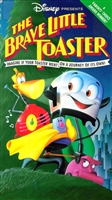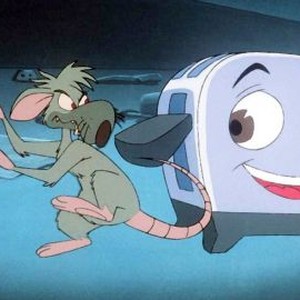
This emotionally direct approach finds an appropriate outlet in the spare, bold animation style, though it is a choice that renders some of the dream sequences almost unintentionally hilarious in their surrealism. The jazzy tune that accompanies said sequence plays both smoothly and deeply, the decrepit vehicles reminiscing days past with lyrics that shame nearly any production by the post-1960 Mouse House for pure existential weight (says a hearse, of all things: “I beg your pardon, it's quite hard enough / Just living with the stuff I have learned”). Toaster’s titular qualities are relished most meaningfully in a decisive act of self-sacrifice, in a set piece pitting the appliances against what can be called the film's Great Satan, a literal hellmouth (a garbage dump trash compactor) that mercilessly destroys used cars and any other items deemed worthless by their former owners. In many such ways does the film embitter its audience to the unfairness of the world, primarily for those who go about it with the best of intentions. Unaccustomed to the mirror image before it, the flower relishes companionship before the toaster flees in fear, the lowly plant wilting soon thereafter in response to its now-assured solitude. When the five animated appliances decide to up and leave their abandoned cottage to search for their “master”-a young boy now grown and long departed from the summer home where our electrical protagonists now reside-one of their first discoveries is that of the surrounding wildlife, and in a life-impacting sequence, the toaster discovers a lone flower in the darkness of the wood. A lesser film might have smothered the beautiful stretches of scenery with some needless third-person voiceover, but Jerry Rees’ is one intimately reliant on often provocative, even disturbing imagery. Disch’s 1980 novel of the same name, the film presents its story of five common appliances-a toaster, an electric blanket, a vacuum cleaner, a lamp, and a radio-much like the intended bedtime narrative of its literary predecessor, at once fable-esque and genuinely hip. Honestly, I think Lasseter came out on the other side of things just fine.Among the finest animated films Disney never made (but would like you to think they did), The Brave Little Toaster employs aesthetic simplicity to deliver an emotional wallop in its evocation of transformative childhood experiences-the dark, often unwanted discoveries that pave the way to a more enlightened adulthood. Lasseter's idea was rejected for being too expensive and a few minutes after the meeting he was called down by an animation administrator who told him he had been fired. Not only was the original written by Joe Ranft, who went on to write Toy Story, A Bug's Life and Cars, a young John Lasseter, the founder of Pixar, tried to convince executives at Disney to make a film with traditionally animated characters featured on CGI backgrounds.

#Brave little toaster movies in order movie
Steve Waterman, who founded the company, has worked on a number of CGI/live-action hybrid movies, serving as an executive producer on the aforementioned Alvin and the Chipmunk movies and as a co-producer on both Stuart Little films.īelieve it or not, The Brave Little Toaster was actually a movie that had a significant impact on the history of Pixar. Disch, is about a group of household appliances that travel a long distance to try and get back to their owner. The story, which was originally based on the children's book by Thomas M.


The Wrap says that while old movie, made back in 1987, centered around household objects like a toaster, a vacuum cleaner, a lamp and a blanket, the new version will contain more modern pieces of technology, such as an iPhone (no joke).


 0 kommentar(er)
0 kommentar(er)
